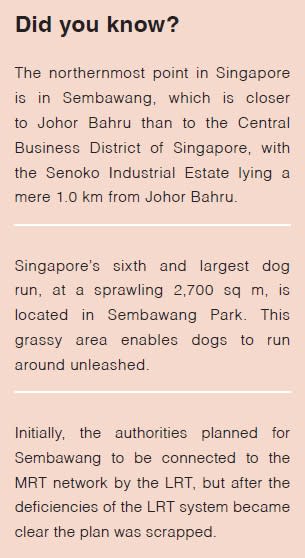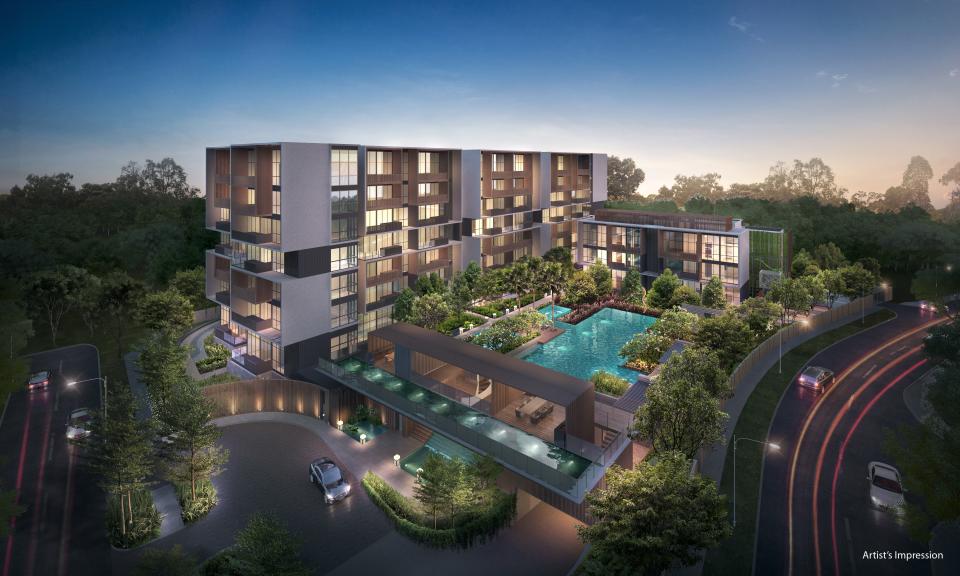Eye on Sembawang: A place by the sea
View of a tranquil river behind Sembawang Road.
Despite many new developments coming up in Sembawang, the suburb retains much of its local character and is popular with those who want to live next door to lush greenery and the sea.
By Joanne Poh
In many neighbourhoods across Singapore, generations-old local eateries are being replaced by hipster cafes and chic cocktail bars. But not in Sembawang – at least, not yet.
This neighbourhood in the north of Singapore has managed to retain much of its local character.
While fashionable local joints selling flat whites rather than kopi have started to appear in Sembawang, residents are still more likely to head out for a hearty zi char meal rather than a stylish Sunday brunch.
A rich history
Many believe the area was named after the Sembawang tree, a local name given to a tree known as Mesua ferruginea. Specimens of this tree can be found in a carpark at Sembawang Park.
Sembawang was formerly the site of the British naval base thanks to its seafront location. Today, the infrastructure of the former naval base is used for commercial purposes and has been taken over by SembCorp Marine.
Many vestiges of Sembawang’s colonial and wartime past can be seen in the present day. For instance, on Bermuda Road, pillboxes from the Second World War remain. On Durban Road, the presence of underground bunkers is betrayed by ventilation shafts peeking out above ground.
Sembawang is also where the former Japanese Theatre at Gibraltar Crescent is located. While the actual use of the theatre is unknown, it has been speculated that Japanese propaganda films were broadcast in the building.
But the area is not just a living testament to Singapore’s colonial and wartime past.
It also happens to be home to one of the last surviving natural beaches in Singapore, the others being in Changi and Labrador.
The original jetty and pier intended for British use are in Sembawang.
The British did not manage to complete the former before the Japanese landed during the Second World War, and it was instead completed by the Japanese. The latter was bombed by the Japanese in 1942, and its remnants still stand today.
An authentic neighbourhood
For residents of modern-day Sembawang, its biggest strength lies in its retention of a certain authenticity, one that has been lost in the frenzied upgrading that has changed many other areas.
For Toh Li Ling, who works in a bank and has been living in Sembawang for more than two decades, the appeal of the area lies in its tranquility.
“Sembawang is a peaceful escape, especially in the shipyard and park area. It is very relaxing to take a drive or cycle in that area and you are transported far from the hustle and bustle of the city,” she said.
When it comes to good food, Sembawang residents are proud of their tried-and-tested lo
cal eateries.
Toh recommends White Restaurant, which is home to the original Sembawang white beehoon and is arguably the area’s most famous eatery.
For a post-work beer and a generous serving of buffalo wings, she heads to Sunset Grill and Pub, an unpretentious joint at nearby Jalan Kayu.
But her favourite place in the area is Sembawang Park due to its tranquility and seaside location. “It’s less crowded (than East Coast Park) and (unlike Punggol) it’s naturally old school and not fake retro,” she said.
The park is extremely scenic thanks to its views over the Johor Straits, and is popular with fishing hobbyists and for barbecues.
Sembawang also has the distinction of being home to the only natural hot spring located on Singapore’s main island at Gambas Avenue. The only other natural hot spring in Singapore is on Pulau Tekong. While the actual spring is enclosed within a brick structure, the water can be accessed through faucets some distance from the spring.
The hot spring receives daily visitors, mostly the elderly, some of whom collect the water in buckets to bring home or soak their feet onsite. The waters of the hot spring are rumoured to have the ability to alleviate conditions like arthritis and eczema.
Sembawang is largely residential, with a mixture of HDB flats and private homes dotting the landscape.
The area is currently served by Sembawang MRT station on the North-South MRT Line and Sembawang bus interchange, as well as the Sembawang Park Connector and Simpang Kiri Park Connector which will in future form a loop that connects all of Singapore’s major parks.
The future of seaside living
Despite Sembawang’s charming local character, changes are slowly but surely afoot.
Fazilla Nordin, Corporate Communications Manager at PropNex Realty said: “With many exciting developments for residents in Sembawang, this area is set to attract upgraders from nearby estates as well as new home buyers. With a good mix of homes near parks and landed properties alongside availability of community-friendly facilities and lifestyle amenities, there is much to look out for as a resident in Sembawang.”
According to Nordin, some infrastructure developments to look out for include an “integrated sports and community hub located five minutes from Sembawang MRT station which will be ready in 2019, as well as an expanded and upgraded intra-town cycling network”.
On the residential front, Watercove is a new residential development that has already proved popular with buyers with at least 18 units being sold ahead of its official launch, thanks in no part to its stunning seafront location.
This rare cluster housing development features 80 freehold strata terrace homes situated at Wak Hassan Drive and consists of 76 terrace units and four semi-detached houses.
The development gives Singaporeans a chance to experience waterfront living at a relatively affordable price. In addition, its proximity to Seletar Aerospace Park may have positive spill-on effects that drive further development of the area and its infrastructure.
The upcoming Kandis Residence is designed to look like a “home in nature” due to its location next to a forested area.
Nordin identified Kandis Residence by Tuan Sing Holdings, located at Jalan Kandis off Sembawang Road, as another residential development to watch for. The 130-unit condominium will be launched in the third quarter of 2017.
Thanks to enhanced transport links and increasingly promising commercial potential, Sembawang’s popularity looks set to grow.
Connectivity to the area will improve greatly in the near future with the opening of Canberra MRT station on the North-South Line, expected in 2019.
Nordin is confident about the appeal of the area now and in the future.
She said: “There are plenty of lifestyle amenities for residents with shopping malls in the region like North Point, Sembawang Shopping Centre and Causeway Point.
“Sembawang residents can also expect more employment opportunities closer to home with the upcoming developments of Woodlands Regional Centre and North Coast Wafer Fabrication Park which will bring jobs closer to residents.”
This article was first published in the print version PropertyGuru News & Views. Download PDFs of full print issues or read more stories now! | |||





